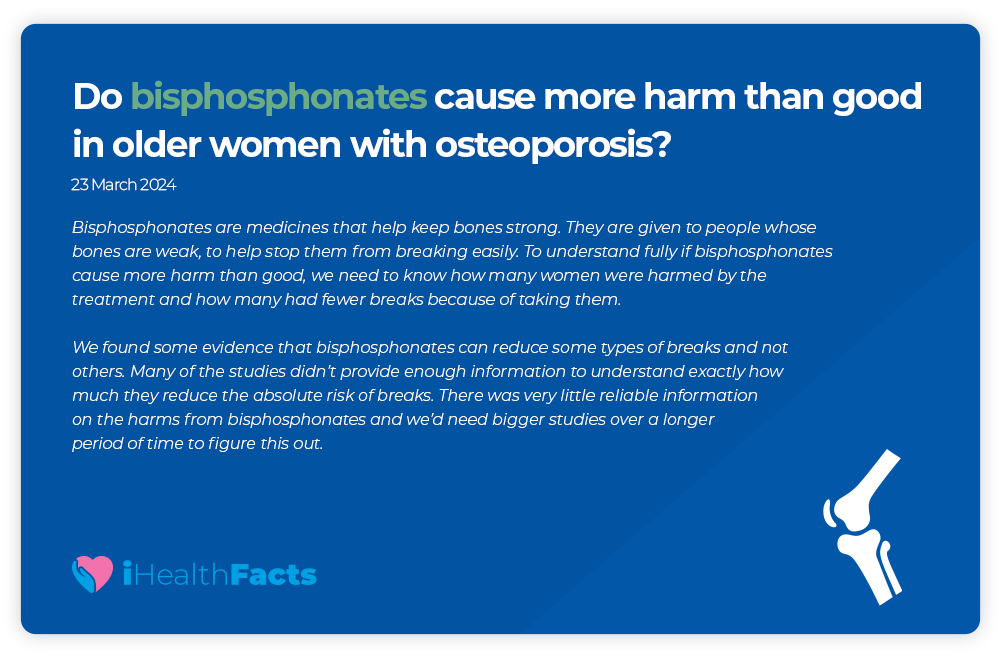The Evidence
- Osteoporosis is a condition when our bones get weak because of decreased bone mass and a change in the structure of the bones. Osteopenia is the loss of bone mass that is not as severe as osteoporosis. Osteoporosis and osteopenia are diagnosed by measuring bone mass density (BMD)
- The decrease in bone mass is a natural part of aging, especially in women after menopause, and it increases the chance of bones breaking (fractures). Other factors apart from bone mass density increase the risk of fractures, including poor health, age, smoking and lack of exercise.
- Bisphosphonates are medicines that help stop bones from getting weaker and are used for treating osteoporosis and diseases like it. Normal, healthy bone cells in our bodies are constantly being slowly removed and replaced with new bone cells. Bisphosphonates work by reducing the breakdown or removal of bone.
- We were asked if bisphosphonates cause more harm than good in older women with osteoporosis. The best way to know for sure whether the benefits outweigh the harms of this medicine is to know the absolute risk of fractures with and without the treatment and the absolute risk of harms. For example, to figure out how much bisphosphonates reduce the risk of fractures, you need to look at randomised studies that show the number of fractures in women who were taking the medicine compared with the number in women who were not taking the medicine.
- We found seven relevant systematic reviews, conducted on this topic, that were published in the last five years. The quality of the reviews was good even though sometimes even a good quality review can have low quality studies included in it.
- Two of the reviews reported the absolute reduction in risk of fractures from bisphosphonates:
- The first systematic review looked at a bisphosphonate called risedronate. The review looked at post-menopausal women at low risk and high risk of fractures, and compared people taking the medicine with those who took a placebo.
- It wasn’t possible to estimate if risedronate had an effect on the number of fractures in low-risk women and there was very little difference in the number of women who stopped the medicine because of side effects (undesirable treatment effects), but they didn’t know if there was any difference in those taking the medicine and placebo in terms of serious side effects. In high risk women, they couldn’t find any information on vertebral (back) fractures. They found that 10 out of 100 women taking placebo had non-vertebral fractures compared with 8 out of 100 taking risedronate; 3 out of 100 women taking placebo had hip fractures compared with 2 out of 100 taking risedronate; and there wasn’t enough information to see if there was any difference in fractures of the wrist.
- The second systematic review looked at the effect of zoledronate, a type of bisphosphonate, on bone fractures in in women with osteoporosis who have gone through menopause
- In women who already had osteoporosis, they found that 8 out of 100 who were taking placebo had fractures compared with 5 out of 100 taking zoledronate. There were similar numbers of non-serious side effects overall in both groups, but about 3 out of 100 taking placebo compared with 8 out of 100 taking zoledronate had side effects overall.
However, a lot of the information in this review comes from one study, which could be biased.
- Five reviews looked at bisphosphonates, but they did not tell us about the absolute reduction in risks (Review 1, review 2, review 3, review 4, review 5)
- Reviews 1, 3 and 4 reported that there were reductions in the risk of some fractures from some of the bisphosphonates but not in others. Review 2 reported a lower risk in people taking bisphosphonates. Review 5 found a reduction in risk but this could have been down to chance.
- Reviews 1 and 3 did not report anything about side effects. Review 2 reported on side effects but did not estimate the overall chance of bisphosphonates causing harm. Review 4 reported an increase in side effects from one type of bisphosphonate and not from another. Review 5 reported an increase in side effects in people taking bisphosphonates that could have been down to chance.
Guidelines and recommendations
- We searched for national and international organisations, including the World Health Organization (WHO), Centers for Disease Control and Prevention (CDC), and Health Service Executive (HSE), for related guidelines and recommendations.
- We did not find any guidelines or recommendations.
- However, we have identified a technology assessment report by the National Institute for Health and Care Excellence (NICE), UK. The report suggested as follows:
- All bisphosphonates showed beneficial effects compared to a placebo.
The report showed no significant differences between the bisphosphonate group and the placebo group in terms of the number of adverse events, mortality and participants stopping the treatment due to side effects.
